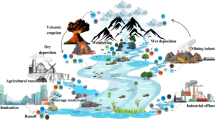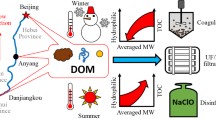Abstract
Eco-ditches are being explored to maximize their capability of capturing pollutants and mitigate any harmful side effects in rivers. In this study, mesocosm plastic drum sediment and field experiments were set up to screen 18 plant species found in ditches and identify those with potential for high biomass production and nutrients removal. Terrestrial plants grown in the mesocosm system were shown to be able to acclimate to aquatic conditions and to survive in primary domestic sewage. About 73–95% increase in plant biomass was recorded. Removal efficiencies for total nitrogen, total phosphorus, and ammonium-nitrogen from the sewage of 72–99%, 64–99%, and 75–100%, respectively, were recorded. Furthermore, complete removal of the applied nitrate-nitrogen load was achieved in mesocosm systems. Findings also show that all species, but especially Acorus calamus, Canna indica, Canna lily, Cyperus alternifolius, Colocasia gigantea, Eichhornia crassipes, Iris sibirica, and Typha latifolia had the highest efficiencies for nitrogen and phosphorous removal. The N and P mass balance analysis demonstrated that plant uptake and sediment N and P accumulation accounted for 41–86% and 18–49% of the total influent TN and TP loads, respectively. In addition, the amounts of nitrogen and phosphorous uptake by these plant species were influenced significantly by biomass. The field-culture experiment further identified Canna indica followed by Cyperus alternifolius as the most promising for high biomass production and nutrients uptake. Therefore, these plants may be recommended for extensive use in treating highly eutrophicated rivers. Outcomes of this work can be useful for model design specifications in eco-ditch mitigation of sewage pollution.




Similar content being viewed by others
References
Belmont MA, Metcalfe CD (2003) Feasibility of using ornamental plants (Zantedeschia aethiopica) in subsurface flow treatment wetlands to remove nitrogen, chemical oxygen demand and nonylphenol ethoxylate surfactants: a laboratory-scale study. Ecol Eng 21:233–247
Bennett ER, Moore MT, Cooper CM, Smith S, Shields FD, Drouillard KG (2005) Vegetated agricultural drainage ditches for the mitigation of pyrethroid-associated runoff. Environ Toxicol Chem 24:2121–2127
Boesch DF (2002) Reversing nutrient over-enrichment of coastal waters: challenges and opportunities for science. Estuaries 25:744–758
Bouldin JL, Farris MT, Moore MT, Cooper CM (2004) Vegetative and structural characteristics of agricultural drainages in the Mississippi Delta landscapes. Environ Pollut 132:403–411
Boyd CE, Gross A, Rowan M (1998) Laboratory study of sedimentation for improving quality of pond effluents. J Appl Aquaculture 8:39–48
Coleman J, Hench K, Garbutt K, Sextone A, Bissonnette G, Skousen J (2001) Treatment of domestic wastewater by three wetland plant species in constructed wetlands. Water Air Soil Poll 128:283–295
Cooper CM, Moore MT, Bennett ER, Smith S, Farris JL, Milam CD (2004) Innovative uses of vegetated drainage ditches for reducing agricultural runoff. Water Sci Technol 49:117–123
Devi R, Dahiya RP, Kumar A, Singh V (2007) Meeting energy requirement of wastewater treatment in rural sector. Energy Policy 35:3891–3897
Diaz FJ, Ogeen AT, Dahlgren RA (2012) Agricultural pollutant removal by constructed wetlands: implications for water management and design. Agric Water Manag 104:171–183
Dong HY, Qiang ZM, Wang WD, Jin H (2012) Evaluation of rural wastewater treatment processes in a county of eastern China. J Environ Monit 14:1906–1913
Greenway M, Woolley A (1999) Constructed wetlands in Queensland: performance efficiency and nutrient bioaccumulation. Ecol Eng 1:39–55
Heather LT, Matthew TM, Martin AL (2012) Influence of three aquatic macrophytes on mitigation of nitrogen species from agricultural runoff. Watter Air Soil Pollut 223:3227–3236
Hoagland CR, Gentry LE, David MB (2001) Plant nutrient uptake and biomass accumulation in a constructed wetland. J Freshw Ecol 16:527–540
Hu MH, Ao YS, Yang XE, Li TQ (2008) Treating eutrophic water for nutrient reduction using an aquatic macrophyte (Ipomoea aquatic Forsskal) in a deep flow technique system. Agric Water Manag 95:607–615
Jayaweera GR, Mikkelsen DS (1991) Assessment of ammonia volatilization from flooded soil systems. In: Brady NC (ed) Advances in agronomy, vol 45. Academic Press, San Diego, pp 303–356
Jeanne D, Cécile D, Jean-Stéphane B, Philippe L, Marc V (2015) Managing ditches for agroecological engineering of landscape: a review. Agron Sustain Dev 35:999–1020
Kadlec RH, Knight RL (1996) Treatment wetlands. CRC Press,Lewis Publishers, Boca Raton 893 pp
Keizer-Vlek HE, Verdonschot PFM, Verdonschot RCM, Dekkers D (2014) The contribution of plant uptake to nutrient removal by floating treatment wetlands. Ecol Eng 73:684–690
Konnerup D, Thammarat Koottatep T, Brix H (2009) Treatment of domestic wastewater in tropical subsurface flow constructed wetlands planted with Canna and Heliconia. Ecol Eng 35:248–257
Kovacic DA, David MB, Gentry LE, Starks KM, Cooke RA (2000) Effectiveness of constructed wetlands in reducing nitrogen and phosphorus export from agricultural tile drainage. J Environ Qual 29:1262–1274
Kröger R, Holland MM, Moore MT, Cooper CM (2007) Hydrological variability and agricultural drainage ditch inorganic nitrogen reduction capacity. J Environ Qual 36:1646–1652
Kröger R, Cooper CM, Moore MT (2008a) A preliminary study of an alternative controlled drainage strategy in surface drainage ditches: low-grade weirs. Agric Water Manag 95:678–684
Kröger R, Holland MM, Moore MT (2008b) Agricultural drainage ditches mitigate phosphorus loads as a function of hydrological variability. J Environ Qual 37:107–113
Kröger R, Moore MT, Farris JL, Gopalan M (2011) Evidence for the use of low-grade weirs in drainage ditches to improve nutrient reductions from agriculture. Water Air Soil Poll 221:223–234
Kumwimba MN, Zhu B, Wang T, Muyembe DK (2016) Distribution and risk assessment of metals and arsenic contamination in man-made ditch sediments with different land use types. Environ Sci Pollut Res 23:24808–24823
Kumwimba MN, Zhu B, Suanon F, Dzakpasu M, Muyembe DK (2017a) Long-term impact of primary domestic sewage on metal/loid accumulation in drainage ditch sediments, plants and water: implications for phytoremediation and restoration. Sci Total Environ 581 (582):773–781. doi:10.1016/j.Scitotenv.2017.01.007
Kumwimba MN, Zhu B, Zhixin D, Jialiang T, Wang T, Liwei X, Muyembe DK (2017b) Assessing nutrient, biomass, and sediment transport of drainage ditches in the Three Gorges Reservoir Area. CLEAN Soil Air Water 45(1). doi:10.1002/clen.201501012
Kumwimba MN, Dzakpasu M, Zhu B, Wang T, Lunda I, Muyembe DK (2017c) Nutrient removal in a trapezoidal vegetated drainage ditch used to treat primary domestic sewage in a small catchment of the upper Yangtze River. Water Environ J 31:72–79
Kumwimba MN, Zhu B, Muyembe DK (2017d) Estimation of the removal efficiency of heavy metals and nutrients from ecological drainage ditches treating town sewage during dry and wet seasons. Environ Monit Assess 189(9):434
Li B, Liao CZ, Zhang XD, Chen HL, Wang Q, Chen ZY, Gan XJ, Wu JH, Zhao B, Ma ZJ, Chen XL, Chen LF, Jiang JK (2009) Spartina alterniflora invasions in the Yangtze River estuary, China: an overview of current status and ecosystem effects. Ecol Eng 35:511–520
Li M, Sheng GP, Wu YJ, Yu ZL, Bañuelos GS, Yu HQ (2014) Enhancement of nitrogen and phosphorus removal from eutrophic water by economic plant annual ryegrass (Lolium multiflorum) with ion implantation. Environ Sci Pollut Res 21:9617–9625
Moore MT, Rodgers JH, Cooper CM, Smith S Jr (2000) Constructed wetlands for mitigation of atrazine-associated agricultural runoff. Environ Pollut 110:393–399
Moore MT, Bennett ER, Cooper CM, Smith S Jr, Farris JL, Drouillard KG, Schulz R (2006) Influence of vegetation in mitigation of methyl parathion runoff. Environ Pollut 142:288–294
Moore MT, Kröger R, Locke MA, Cullum RF, Steinriede RW Jr, Testa S, Lizotte JRE, Bryant CT, Cooper CM (2010a) Nutrient mitigation capacity in Mississippi Delta, USA drainage ditches. Environ Pollut 158:175–184
Moore MT, Kröger R, Locke MA, Cullum RF, Steinriede RW Jr, Testa S (2010b) Nutrient mitigation capacity in Mississippi Delta, USA drainage ditches. Environ Pollut 158:175–184
Needelman BA, Kleinman PJA, Strock JS, Allen AL (2007) Improved management of agricultural drainage ditches for water quality protection: an overview. J Soil Water Conserv 62:171–178
Newman JM, Clausen JC, Neafsey JA (2000) Seasonal performance of a wetland constructed to process dairy milkhouse wastewater in Connecticut. Ecol Eng 14:181–198
Rai UN, Tripathi RD, Singh NK, Upadhyay AK, Dwivedi S, Shukla MK, Mallick S, Singh SN, Nautiyal CS (2013) Constructed wetland as an ecotechnological tool for pollution treatment for conservation of Ganga river. Bioresour Technol 148:535–541
Richardson CJ, Craft CB (1993) Craft, effective phosphorus retention in wetlands: fact or fiction, in constructed wetlands for water quality improvement, Moshiri GA (ed), Chelsea, New York, p 271-282
Scott JT, McCarthy MJ, Gardner WS, Doyle RD (2008) Denitrification, dissimilatory nitrate reduction to ammonium, and nitrogen fixation along a nitrate concentration gradient in a created freshwater wetland. Biogeochemistry 87:99–111
Smith VH (2003) Eutrophication of freshwater and coastal marine ecosystems: a global problem. Environ Sci Pollut Res 10:126–139
Stewart FM, Mulholland T, Cunninghamm AB, Kania BG, Osterlund MT (2008) Floating islands as an alternative to constructed wetlands for treatment of excess nutrients from agricultural and municipal wastes—results of laboratory-scale tests. Land Contam Reclam 16:25–33
Stumm W, Morgan JJ (1996) Aquatic chemistry, chemical equilibria and rates in natural waters. John Wiley & Sons, New York
Tanner CC (1996) Plants for constructed wetland treatment systems—a comparison of the growth and nutrient uptake characteristics of eight emergent species. Ecol Eng 7:59–83
Tucker CS, Hargreaves JA (2003) Management of effluents from channel catfish (Ictalurus punctatus) embankment ponds in the southeastern United States. Aquaculture 226:5–21
Vaillant N, Monnet F, Vernay P, Sallanon H, Coudret A, Hitmi A (2002) Urban wastewater treatment by a nutrient film technique system with a valuable commercial plant species (Chrysanthemum cinerariaefolium Trev.) Environ Sci Technol 36:2101–2106
Vaillant N, Monnet F, Sallanon H, Coudret A, Hitmi A (2003) Treatment of domestic wastewater by an hydroponic NFT system. Chemosphere 50:121–129
Vymazal J (2007) Removal of nutrients in various types of constructed wetlands. Sci Total Environ 380:48–65
Wang L, Gan H, Wang F, Sun X, Zhu Q (2010) Characteristic analysis of plants for the removal of nutrients from a constructed wetland using reclaimed water. Clean- Soil Air Water 38:35–43
Wu WZ, Liu Y, Zhu Q, Wei CJ, Wang JL (2009) Remediation of polluted river water by biological contact oxidation process using two types of carriers. Int J Environ Pollut 38:223–234
Wu M, Tang XQ, Li QY, Yang WJ, Jin F, Tang MZ, Scholz M (2013) Review of ecological engineering solutions for rural non-point source water pollution control in Hubei province, China. Water Air Soil Pollut 224:1561–1578
Xu X, Tan Y, Yang G, Li H (2011) Three Gorges Project: effects of resettlement on nutrient balance of the agroecosystems in the reservoir area. J Environ Plan Manage 54(4):517–537
Zhu B, Wang ZH, Zhang XB (2012) Phosphorus fractions and release potential of ditch sediments from different land uses in a small catchment of the upper Yangtze River. J Soils Sediments 12:278–290
Zou J, Guo X, Han Y, Liu J, Liang H (2012) Study of a novel vertical flow constructed wetland system with drop aeration for rural wastewater treatment. Water Air Soil Pollut 223:889–900
Acknowledgments
The authors are grateful to the Natural Science Foundation of China (Grant No. 41430750), the CAS Western Light Plan, and the Chinese Academy of Sciences—the Third World Academy of Sciences (CAS-TWAS) President’s Fellowship program for developing countries for financial support of this work.
Author information
Authors and Affiliations
Corresponding author
Additional information
Responsible editor: Philippe Garrigues
Electronic supplementary material
Table S1
(DOCX 11 kb)
Rights and permissions
About this article
Cite this article
Kumwimba, M.N., Zhu, B., Muyembe, D.K. et al. Growth characteristics and nutrient removal capability of eco-ditch plants in mesocosm sediment receiving primary domestic wastewater. Environ Sci Pollut Res 24, 23926–23938 (2017). https://doi.org/10.1007/s11356-017-9992-3
Received:
Accepted:
Published:
Issue Date:
DOI: https://doi.org/10.1007/s11356-017-9992-3




